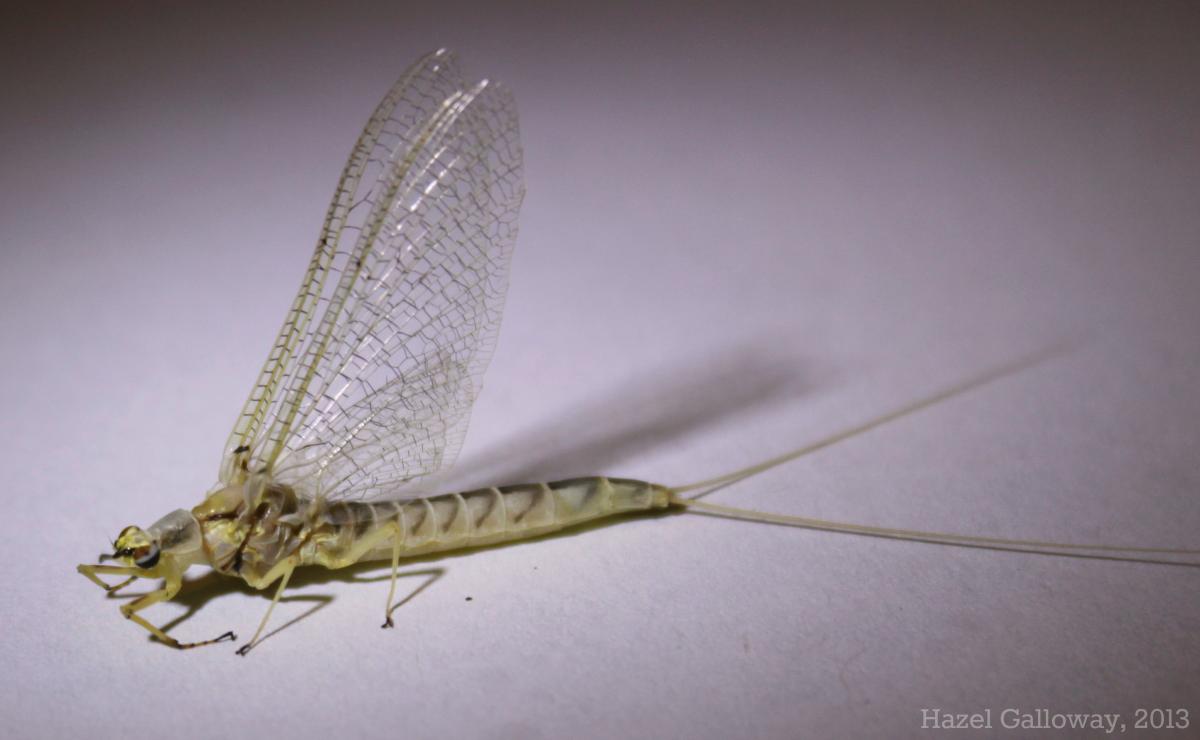Together with dragonflies and damselflies, mayflies are the only extant winged members of the infraclass Paleoptera. All other insects with wings belong to the Neoptera, and have a joint enabling them to fold their wings back over their abdomens when at rest. Mayflies, lacking this ability, characteristically hold their wings up vertically over their body when stationary.
Upon first hatching from eggs, mayfly nymphs are less than 1 mm in length. They generally spend a full year (although it can be two in northern areas) as nymphs on rocky streambeds or at the bottoms of other bodies of water. The nymphs have oval-shaped gills along the sides of their bodies; the gills are typically smaller in species such as Hexagenia limbata that dwell primarily in running water, and larger in other species that make their home in ponds and lakes where less oxygen is readily available from the surrounding environment. Apart from absorbing oxygen,  salts, and water, the gills serve to expel water at right angles away from the nymph’s body, instead of directly behind it. Most predators expect a stream of water to issue from the rear of a gilled insect and are misled by the conflicting currents, affording the mayfly some degree of protection. The nymphs molt a number of times as they increase in size—in some species, they pass through as many as 20 skins before reaching adulthood.
salts, and water, the gills serve to expel water at right angles away from the nymph’s body, instead of directly behind it. Most predators expect a stream of water to issue from the rear of a gilled insect and are misled by the conflicting currents, affording the mayfly some degree of protection. The nymphs molt a number of times as they increase in size—in some species, they pass through as many as 20 skins before reaching adulthood.
When a nymph is ready to transform into its adult form, it empties its digestive system and fills it with air, simultaneously releasing their hold on the streambed and rising rapidly to the surface of the water. Floating on the surface, they molt once more, revealing wings not yet strong enough to bear their weight in flight. In many species, including H. limbata, this life stage takes the form of a mass emergence that occurs almost simultaneously throughout the entire population. The creatures are at their most vulnerable at this time in their lives, and the evenings upon which the “hatches” occur are a fabled time with fly fishermen. The swarms of newly-winged adults (“subimagoes”) eventually clear the water and settle on overhanging trees, grass, or the undersides of bridges to molt one last time. This final molt—the only known case of an insect molting after developing wings—allows their tails and legs to increase to their full size. They are now “imagoes”—fully-fledged adults.
Then, like locusts, masses of mayflies rise into the air in swarms so huge and dense that they have been known to appear on Doppler radar. Males, using their multiple elongated tails as flight rudders, fly in a shifting, undulating mass some distance above the ground. They attempt to mate any females that enter the swarm, grabbing them in their legs and drifting to the ground. After mating, males typically mate-guard the females until deposit their tiny eggs, in twos and threes, into the water. The entire adult lifespan of a mayfly is only one or two days. However, even after death, these prolific but ephemeral insects do not simply disappear. Vast quantities of dead insects have been known to pile up on porches, windowsills, cars, and roadways, causing a very real traffic hazard until snowplows can be called to the scene.
This remarkable creature was caught by Laura Galloway, and likely matured in a flowing streambed near the station. Although they are rare and largely unnoticed on the mountain, there can be little doubt that this least impressive of organisms deserves as much consideration as the most.
Hazel Galloway
See this loop of a mayfly emergence caught on doppler radar from the National Weather Service!
Sources:



